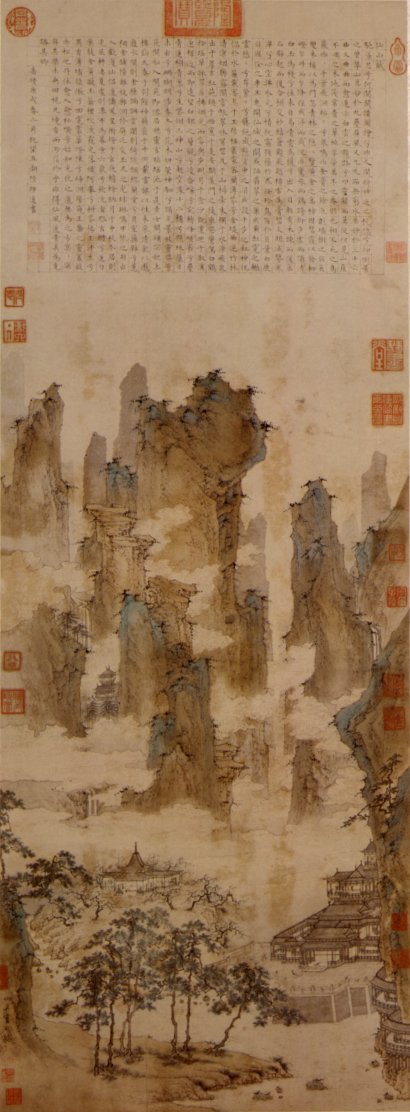
Ming Dynasty (1368 - 1644)
At the beginning of the Ming Dynasty, the styles of the Yuan literati painters were still practiced, but there also developed a style of painting that looked back to the achievements of the Southern Sung Academy and the art of ink washing painting. Towards the middle of the Ming Dynasty, the gentle and untrammeled elegance of the Yuan scholars’ painting once again became an object of veneration.

Pang
Gu Su (Dong Chi-Tsun)
|
沈周 Shen Zhou (1427-1509) |
|
Portrait of Shen Zhou Shen Zhou was born into a scholar's family as his father and uncle were renowned painters and scholars. His grandfather was a good friend of Wang Meng. Unlike other painters or intellectuals, he did not seek a government post. Instead, he enjoyed traveling, poetry, and painting. Starting with his father, uncle, and teachers, Shen Zhou also studied and imitated the brushstrokes of Dong Yuan, Ju Ran, Mi Fu, Mi You-Ren, and the Four Great Masters of Yuan painting. From the age of forty to sixty, he continued to use the brushwork manner of the predecessors, yet he transformed their techniques into his own style, and was even capable of combining the predecessors' brushwork styles in a seamless manner. His efforts to master the various brushwork manners of earlier landscape painters led to the pursuit of form at the expense of content by other painters of the late Ming Dynasty. Due to his influence, literati painting eventually came to be enjoyed by a much wider audience than before. Unlike other court painters such as Lin Liang ( 林良 ), Shen Zhou emphasized more on conveying thoughts, feelings, and even overtones by combining paintings with poetry, essays, and calligraphy. After his passing, his student Wen Zheng-Ming ( 文徵明 ) gathered around him many students from Suzhou ( 蘇州 ), the birthplace of Wu School of Painting ( 吳門畫派 ), and popularized literati painting. Wu ( 吳 ) was the ancient geographical area centered on the city of Suzhou, where Shen Zhou lived all his life. Artists of the Wu tradition (not a school in the strict sense) were literati or scholar-amateurs who emphasized the importance and interdependence of poetry, painting and calligraphy. Their aesthetic ideals and aims were thus in direct contrast with those of the professional and court painters of the Zhe School ( 浙派 ), the leading exponent of which was Dai Jin ( 戴進 ). Shen Zhou, Wen Zheng-Ming, Tang Ying, and Chiu Ying came to be known as the Four Great Artists of Wu ( 吳門四家 ).
Lofty Mount Lu ( 廬山高圖 ) follows the manner of Wang Meng ( 王蒙 ) in both composition and brushwork. Painted as a birthday gift for his teacher Chen Kuan ( 陳寬 ), Shen Zhou painted the height and grandeur of the mountain and inscribed the long poem in honor of his teacher's virtues and strong character.
|

Lady (Tang Yin 唐 伯 虎)
Wen Zheng-Ming

Chiu Ying